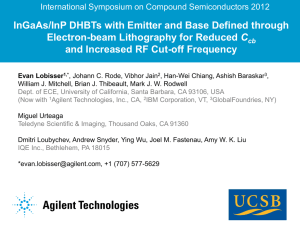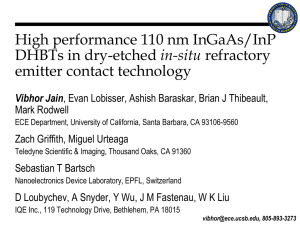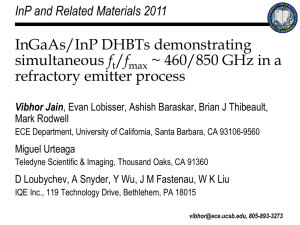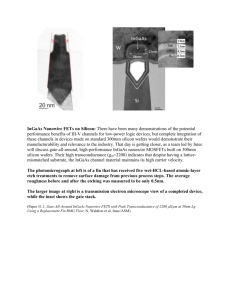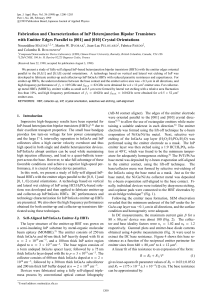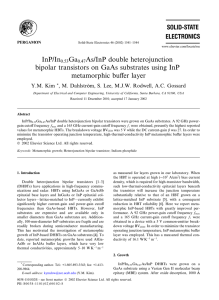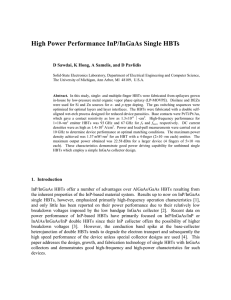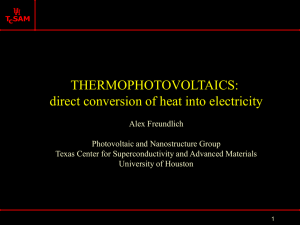2011_5_may_ISCS_Jain_presentation.ppt
advertisement
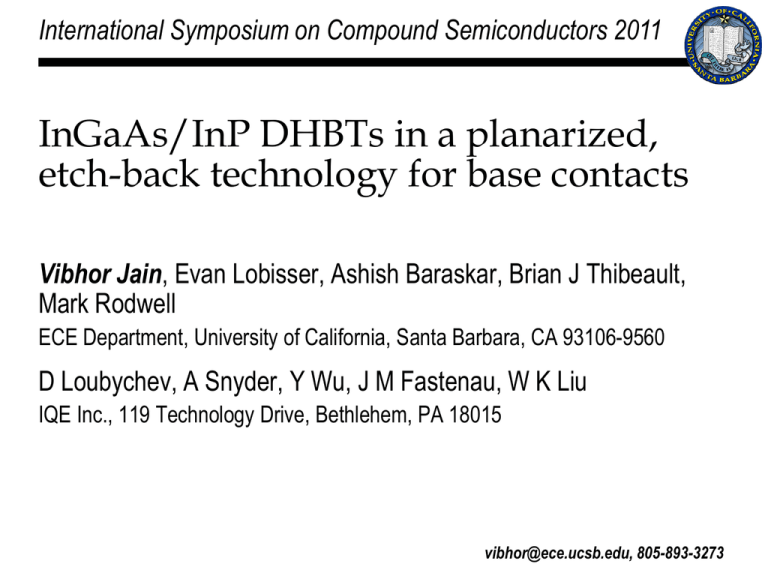
International Symposium on Compound Semiconductors 2011 InGaAs/InP DHBTs in a planarized, etch-back technology for base contacts Vibhor Jain, Evan Lobisser, Ashish Baraskar, Brian J Thibeault, Mark Rodwell ECE Department, University of California, Santa Barbara, CA 93106-9560 D Loubychev, A Snyder, Y Wu, J M Fastenau, W K Liu IQE Inc., 119 Technology Drive, Bethlehem, PA 18015 vibhor@ece.ucsb.edu, 805-893-3273 1 Outline • HBT Scaling Laws • Refractory base ohmics • Fabrication • DHBT – Epitaxial Design and Results • Summary 2 Bipolar transistor scaling laws 1 tr RC 2f f max f 8Rbb,eff Ccb ,eff We Tb Wbc Tc To double cutoff frequencies of a mesa HBT, must: Keep constant all resistances and currents Reduce all capacitances and transit delays by 2 b Tb2 2 Dn Tb vexit c Tc 2v sat Ccb Ac /Tc (emitter length Le) Epitaxial scaling I c,max veff Ae (Vcb bi ) / T Rex contact /Ae 2 c We Wbc contact Rbb sheet 12 Le 6 Le Acontacts Lateral scaling Ohmic contacts 3 InP bipolar transistor scaling roadmap 256 128 64 32 Width (nm) 8 4 2 1 Access ρ (Ω·µm2) 175 120 60 30 Contact width (nm) 10 5 2.5 1.25 Contact ρ (Ω·µm2) 75 53 37.5 Thickness (nm) Current density 9 18 36 72 mA/µm2 Breakdown voltage 4 3.3 2.75 2-2.5 V 730 1000 1400 GHz 1300 2000 2800 GHz Design Emitter Base Performance Collector 106 fτ 520 fmax 850 Rodwell, Le, Brar, Proceedings of IEEE, 2008 4 TEM by E Lobisser Contact diffusion 15 nm Pd diffusion Ashish Baraskar • Pd contacts diffuse in base (p-InGaAs) • Contact resistance ↑ for thin base • Limits base thickness Scaling Limitation 100 nm InGaAs grown in MBE Need for non-diffusive, refractory base metal 5 Ashish Baraskar et al., EMC 2010 Ashish Baraskar et al., Int. MBE 2010 Refractory base ohmics Doping 1.5E20 1.5E20 1.5E20 1.5E20 2.2E20 2.2E20 Metal Mo Ru/Mo W/Mo Ir/Mo Ir/Mo Ir/Mo Type As deposited As deposited As deposited As deposited As deposited Annealed c (W-mm2) 2.5 1.3 1.2 1.0 0.6 0.8 Refractory metal base contacts Require a blanket deposition and etch-back process 6 Emitter process flow SiO2/Cr Mo SiN (SW) n+ InGaAs TiW W Mo emitter cap n InP emitter base N- collector sub collector InP substrate Mo contact to nInGaAs for emitter emitter cap emitter base emitter base W/TiW/SiO2/Cr dep SiO2/Cr removal SF6/Ar etch InGaAs Wet Etch SiNx Sidewall base Second SiNx Sidewall InP Wet Etch W/TiW interface acts as shadow mask for base lift off Collector formed via lift off and wet etch BCB used to passivate and planarize devices 7 Base process flow – I Blanket refractory metal PR Planarization Isotropic Dry etch of metal Removes any Emitter-Base short Ti0.1W0.9 Ti0.1W0.9 W W Mo InGaAs InP p+ InGaAs Base PR Mo InGaAs InP p+ InGaAs Base 8 Base process flow – II Lift-off Ti/Au Blanket SiNx mask Low base metal resistance Etch base contact metal in the field SiNx Ti0.1W0.9 Ti0.1W0.9 W W Mo InGaAs InP Mo InGaAs InP p+ InGaAs Base p+ InGaAs Base 9 Base Planarization Planarization: Emitter projecting from PR for W dry etch Etch Back Planarization Boundary 10 Epitaxial Design 1.5 Material Doping (cm-3) Description 10 In0.53Ga0.47As 81019 : Si Emitter Cap InP 51019 15 : Si Emitter 15 InP 21018 : Si Emitter 30 InGaAs 9-51019 : C Base 4.5 In0.53Ga0.47 As 91016 : Si Setback 10.8 InGaAs / InAlAs 91016 : Si B-C Grade 3 InP 6 1018 : Si Pulse doping 81.7 InP 91016 : Si Collector 7.5 InP 11019 : Si Sub Collector 7.5 In0.53Ga0.47 As 21019 : Si Sub Collector 300 InP 21019 : Si Sub Collector Substrate SI : InP 1 0.5 Energy (eV) T(nm) 0 -0.5 -1 -1.5 Emitter Base -2 Collector -2.5 0 50 100 Distance (nm) 150 200 Vbe = 1 V, Vcb = 0.7 V, Je = 25 mA/mm2 Low Base doping Good refractory ohmics not possible Pd/W contacts used 11 Results - DC Measurements Common emitter I-V 2 P = 25 mW/mm I b,step = 200 mA @Peak f,fmax 2 Je (mA/mm ) 30 Je = 17.9 mA/mm2 Peak f /f 20 max P = 30 mW/mm2 10 I = 200 mA Solid Line: V b 0 0.5 1 V 2 2.5 cb Dashed Line: V -3 10 cb =0V I = 0.7 V c BVceo = 2.4 V @ Je = 1 kA/cm2 -5 10 b n = 3.29 b n = 1.76 β = 26 JKIRK = 21 mA/mm2 c I b ce 1.5 (V) I , I (A) 0 -1 10 c -7 10 0 Gummel plot 0.2 0.4 0.6 V (V) be 0.8 1 12 1-67 GHz RF Data MSG H Gain (dB) 30 f = 410 GHz 21 f U max = 690 GHz Ic = 22.4 mA 20 Vce = 1.67 V Je = 17.9 mA/mm2 10 A = 0.22 × 5.7 mm 2 Vcb = 0.7 V je 0 9 10 10 10 10 freq (Hz) 11 10 12 Single-pole fit to obtain cut-off frequencies 13 Equivalent Circuit Ccb,x = 4.48 fF Rex = 6 Wmm2 Rcb = 17 kW Rbb = 24 W Ccb,i = 1.3 fF Rc = 1.7 W Base Col Rbe = 42 W S21/12 Ccg = 6.8 fF Cje + Cdiff = (15 + 241) fF S12x5 Rex = 4.7 W gmVbee-j 0.73Vbeexp(-j0.15ps) Emitter --- : Measured x : Simulated S11 S22 Hybrid- equivalent circuit from measured RF data 14 TEM Large undercut in base mesa Pd/W adhesion issue High Rbb Low fmax 0.1 mm Pd/W adhesion issue Large mesa undercut 15 Summary • Demonstrated a planarized, etch back process for refractory base contacts • Demonstrated DHBTs with peak f / fmax = 410/690 GHz • Higher base doping, thinner base and refractory base ohmics needed to enable higher bandwidth devices 16 Thank You Questions? This work was supported by the DARPA THETA program under HR0011-09-C-006. A portion of this work was done in the UCSB nanofabrication facility, part of NSF funded NNIN network and MRL Central Facilities supported by the MRSEC Program of the NSF under award No. MR05-20415 17
